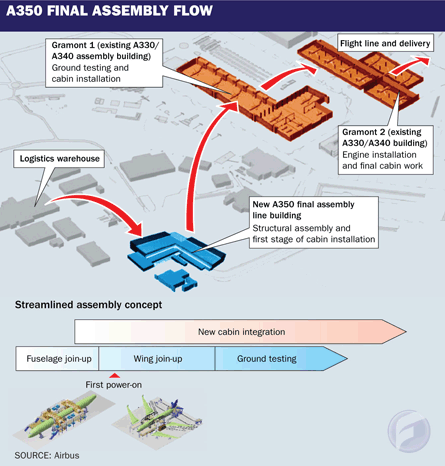Airbus has devised its A350 production plan to enable output levels of up to 10 aircraft a month, with the final assembly line capable of ultimately delivering up to 13 a month.
By increasing the state of subassembly completion, as well as integrating cabin installation with the assembly process, Airbus aims to reduce the lead time of the A350 by 30% compared with the current A330/A340. The A350’s optimised production process will see “power-on” being achieved for the first time in an Airbus aircraft after fuselage join-up, but before wing-mating, enabling cabin installation to begin earlier.
“This is achieved due to the higher level of completion that we will require for sections when delivered to the final assembly line,” says A350 industrial programme management chief Philippe Launay.
“For example, A350 nose fuselage sections will have wiring harnesses installed and have been tested before delivery to Toulouse,” he says. On the A330/A340 this happens during final assembly. The A350 process “allows a better overlapping of the activities and consequently enables power-on to take place sooner in the process”.
 |
|---|
Final assembly will be undertaken using a mix of new and existing infrastructure in Toulouse, with the centrepiece being a new L-shaped building in which all structural assembly will take place.
“These new building will contain new jigs and tools and will be used for fuselage and wing join-up, and the first phase of cabin installation,” says Launay. “After this, we will use the two existing A330/A340 final assembly line buildings for all the aspects of ground test and the continuation of cabin installation.”
The two A330/A340 assembly buildings are dubbed “Gramont 1” and “Gramont 2” – the first one currently being used for structural assembly (ie wing/fuselage join-up) and ground testing, and the second for cabin installation.
“For the A350 we will use the test stations in Gramont 1 for all ground test activities,” says Launay. Cabin work will continue through the ground-testing phase and aircraft will be moved to the Gramont 2 site for the completion of the interior and the installation of engines. “This will be where the very expensive cabin items are installed – as late as possible – for example the premium cabin seats,” says Launay. Once this work is completed, A350s will be moved to the flight line and prepared for delivery to customers.
 |
|---|
© Airbus |
Meanwhile, Airbus is working to ensure that negotiations over the allocation of the final work packages do not become a pacing factor for the programme, and so will initially place the work in Europe.
“We are still competing the rudder and elevator work, which is a candidate for international co-operation offset with China,” says Launay. “While we are still discussing this with China, we are ready to start
production by undertaking the work in Europe and then managing the transfer to China. We will secure our ramp-up plan by transferring work to China when there is the right level of maturity.”
Source: Flight International



















